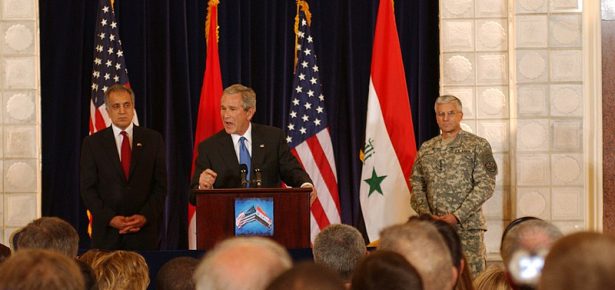
So said former CIA Director R. James Woolsey to the House Armed Services Committee in 1999, channeling what had become a consensus about Iraq in the U.S. foreign policy establishment by the end of the 1990s: that Saddam Hussein could no longer be contained because he was fixated on shedding sanctions and inspections, rebuilding his weapons of mass destruction, and again trying to dominate the Persian Gulf.
Saddam’s intentions, according to the dominant perspective, stemmed from the nature of his totalitarian regime and would not change merely through the pressures of containment. The only solution to the Iraqi threat was regime change, which meant not just the toppling of Saddam but the uprooting of the tyrannical Baathist regime and the cultivating of a democracy in Iraq.
I became interested in the containment of Iraq while teaching a high school elective on the War on Terror in Western Massachusetts. To teach this course, I mined the extensive journalism and scholarship on the war’s origins, but I found little on why so many prominent Americans came to view containment as a failure.
This was puzzling given that containment limited Saddam’s military recovery from the Gulf War, crippled the Iraqi economy, and, as the United States discovered after invading Iraq, seriously inhibited his pursuit of weapons of mass destruction. This seemed like a critical question because containment was the primary alternative to a strategy of regime change in Iraq, and the discrediting of containment left the United States with only one option, apparently.
My book intertwines the history of the policy of containment with the politics, ideas, and personalities of the post-Cold War United States. I show how repeated frustration with Saddam’s defiance of U.N. weapons inspectors, his human rights abuses, and his violation of the sanctions regime drove more U.S. politicians, policy-makers, and intellectuals into the regime change camp over the course of the decade. I show how this consensus came to include not just neoconservatives, the usual suspects for explaining the Iraq War, but Democrats, Republicans, liberals, humanitarian interventionists, and Iraqi exiles.
The Regime Change Consensus sheds new light on the U.S. decision to invade Iraq, the most consequential foreign policy decision of the 21st century so far. I show how the discrediting of containment during the 1990s not only motivated the Bush administration to pursue regime change in Iraq following September 11 but how this process primed the larger foreign policy establishment, including the leadership of both major parties, to accept most of Bush’s case for war.
Many Democrats, major media outlets, and foreign policy experts criticized how Bush was pursuing regime change, pointing out holes in the administration’s handling of the evidence on weapons of mass destruction and the need for better planning for postwar occupation. However, because the larger establishment had come to accept the inadequacy of containment prior to September 11, its members largely accepted the wisdom, necessity, and prudence of regime change in Iraq.
Thus, my book explains not just how one president but the majority of a country, including most of its political elite, came to support a decision that ended in disaster both for Americans and Iraqis.
Latest Comments
Have your say!